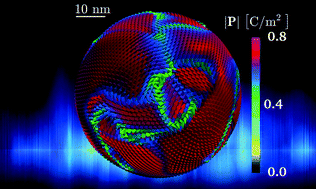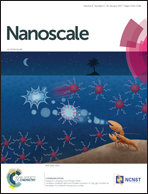Topological phase transformations and intrinsic size effects in ferroelectric nanoparticles†
Abstract
Composite materials comprised of ferroelectric nanoparticles in a dielectric matrix are being actively investigated for a variety of functional properties attractive for a wide range of novel electronic and energy harvesting devices. However, the dependence of these functionalities on shapes, sizes, orientation and mutual arrangement of ferroelectric particles is currently not fully understood. In this study, we utilize a time-dependent Ginzburg–Landau approach combined with coupled-physics finite-element-method based simulations to elucidate the behavior of polarization in isolated spherical PbTiO3 or BaTiO3 nanoparticles embedded in a dielectric medium, including air. The equilibrium polarization topology is strongly affected by particle diameter, as well as the choice of inclusion and matrix materials, with monodomain, vortex-like and multidomain patterns emerging for various combinations of size and materials parameters. This leads to radically different polarization vs. electric field responses, resulting in highly tunable size-dependent dielectric properties that should be possible to observe experimentally. Our calculations show that there is a critical particle size below which ferroelectricity vanishes. For the PbTiO3 particle, this size is 2 and 3.4 nm, respectively, for high- and low-permittivity media. For the BaTiO3 particle, it is ∼3.6 nm regardless of the medium dielectric strength.



 Please wait while we load your content...
Please wait while we load your content...